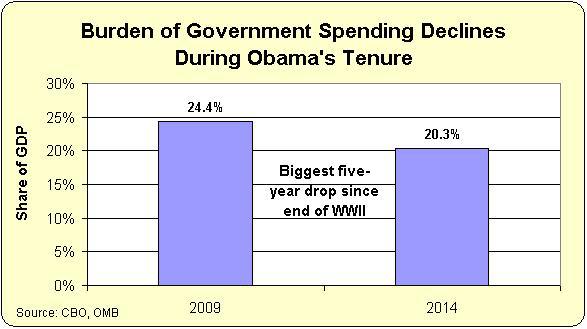

Earlier this month, Americans for Prosperity held a “Road to Reform” event in Las Vegas. I got to be the warm-up speaker and made two simple points. First, we made a lot of fiscal progress between 2009 and 2014 because various battles over debt limits,shutdowns, and sequestration actually did result in real spending discipline. Second, I used January’s 10-year forecast from the Congressional Budget Office to explain how easy it would be to balance the budget with a modest amount of future spending restraint.

Federal Spending from start of Obama administration to the present. (Source: Dan Mitchell)
Here’s my speech (you can see the entire event on YouTube).
I realize I sound uncharacteristically optimistic in these remarks, but it is amazing how easy it is to make progress with even semi-effective limits on the growth of government. Genuine spending cuts would be very desirable, of course, but we move in the right direction so long as government spending grows slower than the private sector. The challenge, needless to say, is convincing politicians to limit spending.
Well, we now have some new data in that battle. The CBO released its Update this morning, which means the numbers I shared in Nevada are now slightly out of date and that I need to re-do all my calculations based on the new 10-year forecast. But it doesn’t really make a difference. As you can see from the chart, we can balance the budget by 2021 if spending is capped so that it grows by 2 percent annually. And even if spending is allowed to grow by 3 percent per year (about 50 percent faster than projected inflation), the budget is balanced by 2024.
At this point, I feel compelled to point out that the goal should be smaller government, not fiscal balance. But since fiscal policy debates tend to focus on how to eliminate red ink and balance the budget, I may as well take advantage of this misplaced focus to push a policy–a spending restraint policy–that would be desirable even if we had a budget surplus.
And that’s the purpose of another video I narrated for the Center for Freedom and Prosperity back in 2010. The numbers obviously have changed over the past five years, but the underlying argument about the merits and efficacy of spending restraint are exactly the same today.
For more information on the merits of smaller government, here’s my tutorial on government spending.







